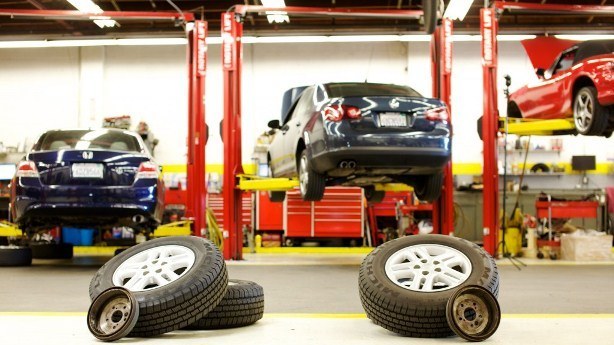All Categories
Featured

[/image]

Maintaining your automobile's tires is important to make sure a smooth, secure, and effective driving experience. 2 vital services that are often ignored yet have a significant influence on tire durability and performance are tire rotation and positioning. These services aid keep your automobile running successfully and avoid unequal tire wear that can impact both safety and security and gas economy. Allow's dive right into what tire turning and placement are and why they are essential for your automobile.
What Is Tire Turning? Tire turning is the procedure of relocating your tires from one setting to another to ensure they put on evenly. Since your auto's tires operate at different prices relying on their setting (front tires versus rear tires), rotating them on a regular basis helps to disperse the wear evenly, bring about a much longer life expectancy for your tires.
Tires on the front axle tend to wear quicker than those on the back axle, specifically in front-wheel-drive cars and trucks, where the front tires manage both steering and power. On the various other hand, back tires might use erratically relying on the lorry's weight circulation and driving problems. By rotating your tires every 6,000 to 8,000 miles (or as recommended by the producer), you'll make sure an extra balanced wear pattern.
What Is Tire Placement? Tire placement, additionally known as wheel positioning, describes changing the angles of your cars and truck's wheels to the supplier's specs. Appropriate placement makes sure that your tires are pointing in the ideal instructions, and it assists optimize tire life and boost vehicle handling. There are three primary elements of positioning: camber, caster, and toe.
Camber describes the tilt of the tires from the front of the automobile. If your tires are tilted as well much inward or external, it can trigger unequal wear. Wheel describes the angle of the guiding axis when seen from the side of the car. This influences the security of the guiding, especially when driving right. Toe refers to the angle at which the tires direct inward or outward when watched from above. This affects just how your car tracks when traveling. A correct alignment ensures that all four tires are directing directly ahead and are angled properly. Misalignment can result from striking splits, visuals, or just from the wear of suspension parts over time.
Why Tire Turning and Positioning Issue. Extended Tire Life. Both tire rotation and alignment assistance avoid uneven tire wear. When your tires wear evenly, they last longer, which can conserve you money in the long run by reducing the need for premature replacements.
Improved Safety And Security. Appropriate tire rotation and positioning enhance automobile stability and handling. Misaligned tires or erratically used tires can adversely influence your capacity to guide and quit your automobile, especially in emergency circumstances. Regular maintenance ensures your tires perform efficiently, giving a safer driving experience.
Much Better Fuel Effectiveness. If your tires are not aligned properly, they might drag against the road surface area, creating resistance. This additional rubbing can lower gas efficiency, triggering your car to eat more gas. Normal tire placement guarantees that your automobile moves efficiently, boosting gas mileage.
Boosted Convenience. Imbalance or unevenly used tires can bring about a rougher trip, as your automobile might draw to one side or cause vibrations. By maintaining your tires turned and lined up, you'll take pleasure in a smoother and much more comfy driving experience.
Signs That Your Tires Required Turning or Positioning. It's necessary to stay alert for any indications that your tires require turning or placement. Keep an eye out for these usual signs:
Unequal Tire Wear: If you discover that tire is considerably extra worn than the others, it might be time for a rotation or positioning. Steering Pull: If your cars and truck pulls away while driving directly, this might suggest imbalance. Resonances: If you really feel resonances in the guiding wheel or the automobile itself, maybe a sign of misalignment or uneven tire wear. Screeching Tires: Uncommon tire sound might also indicate incorrect alignment or the requirement for a tire rotation. How Typically Should You Revolve and Straighten Your Tires? Tire rotation must usually be done every 6,000 to 8,000 miles or as defined in your automobile's owner's manual. It's an excellent idea to revolve your tires during every oil modification, as this will certainly help you remain on top of regular upkeep.
As for positioning, it does not require as regular solution. Generally, alignment ought to be checked at the very least as soon as a year or whenever you discover concerns like drawing to one side or vibration. You may also require placement if you have actually hit a big hole or aesthetic, which can throw your wheels out of positioning.
Conclusion: Maintain Your Tires in Leading Shape. Tire rotation and alignment are crucial solutions that maintain your vehicle running efficiently, safely, and efficiently. By taking the time to have your tires rotated and aligned routinely, you're investing in your auto's performance and longevity, while additionally boosting your safety and security when traveling. Keep proactive with tire upkeep, and your vehicle will thank you with much better fuel economic climate, enhanced handling, and extended tire life.
Latest Posts
Uncover Exceptional Car Repair Solutions from Montclare Auto Repair – Keep Your Car Running Smoothly
Explore Premier Vehicle Maintenance Services from Montclare Auto Repair – Keep Your Car Running Smoothly
Specialist Business Roofing Solutions in North Platte, Nebraska
More
Latest Posts
Uncover Exceptional Car Repair Solutions from Montclare Auto Repair – Keep Your Car Running Smoothly
Explore Premier Vehicle Maintenance Services from Montclare Auto Repair – Keep Your Car Running Smoothly
Specialist Business Roofing Solutions in North Platte, Nebraska